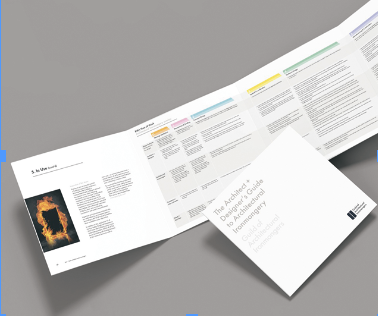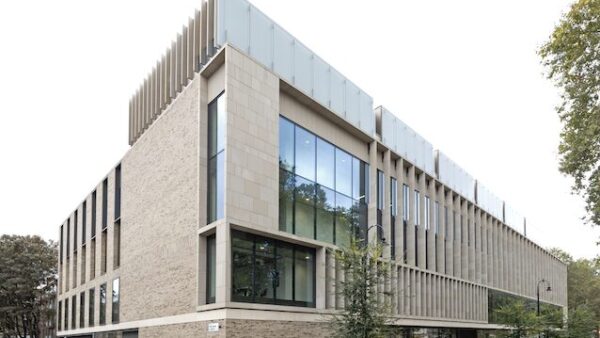
The GAI has launched a new guide: The Architect + Designer’s Guide to Architectural Ironmongery. It is based on the RIBA Plan of Work which is a highly-regarded and widely-used framework for the planning and management of architectural projects. Published by the Royal Institute of British Architects (RIBA), it is an essential resource for architects and other construction professionals, providing a structured approach to project planning, design, and management.
In a world now defined by competence and ethics, digital innovation, safety and compliance, the Golden Thread, accountability and sustainability, the Plan of Work has never been more relevant. Why? It encourages collaboration between project stakeholders; it provides a clear roadmap for project management and delivery; it is adaptable to various project types, scales, and procurement methods; and it promotes the use of industry best practices and standards.
Many architectural ironmongers will never have been introduced to the RIBA Plan of Work and view it as a tool for architects. However, it is an excellent resource for ALL designers and specifiers. One leading interior design professional body holds it in such esteem it has now based its design contracts on the Plan of Work. And the GAI has based its latest guide to AI on it. RIBA says in the introduction to its Plan of Work Overview 2020: “Of course, any client is welcome to interpret the RIBA Plan of Work in their own way and to set their own overlay of tasks or documents. In a world of continuous change, bringing clarity to each stage allows everyone involved to develop their own innovations, without the perpetual need to discuss the strategic aspects of who should do what when.”
The eight stages and the role of the architectural ironmonger
The RIBA Plan of Work is divided into distinct stages, each with specific tasks and objectives. The eight stages, numbered 0 to 7 each represent a phase in the project lifecycle and is designed to ensure that all aspects of the project are considered and addressed.
GAI members might like to take note of stages 3, 4, 5, 6 and 7 (although early involvement ensures that the ironmonger’s expertise is considered in the project planning). Stages 3 and 4 are when the architectural ironmonger’s role becomes significant in specifying and detailing the required ironmongery products, considering functionality, aesthetics, building regulations, and standards compliance. It also involves securing the order for the specified ironmongery product.
The RIBA Plan of Work eight stages
RIBA Stage 0: Strategic Definition
In this stage, the project’s objectives, constraints, and requirements are defined. Stakeholders are identified, and their needs and expectations are considered.
RIBA Stage 1: Preparation and Brief
The project brief is developed, outlining the client’s requirements, project scope, and key performance indicators. A feasibility study may be conducted to assess the project’s viability.
RIBA Stage 2: Concept Design
Initial design concepts are developed, and the preferred design solution is chosen. This stage includes preliminary cost estimates and risk assessments.
RIBA Stage 3: Spatial Coordination
The chosen design concept is developed into a coordinated architectural, structural, and services design. This stage includes the preparation of planning applications, building regulations submissions, and detailed cost estimates.
RIBA Stage 4: Technical Design
Technical details are finalised, including specifications, schedules, and drawings. The design is coordinated with other disciplines, and any necessary adjustments are made.
RIBA Stage 5: Construction
The project is constructed according to the technical design, with regular
site inspections and progress reports to ensure quality and compliance with the design.
RIBA Stage 6:Handover and Close-out
The project is handed over to the client after construction. Any defects or issues are rectified, and final documentation is provided.
RIBA Stage 7: In Use
The performance of the completed project is monitored and evaluated. Feedback is collected to inform future projects and improve the design process.
Stage 5 involves the supply of hardware and material that have been procured, according to the contractor’s delivery programme. It also involves the architectural ironmonger working closely with the contractors to ensure that the specified ironmongery is installed correctly. This might involve conducting site visits, quality checks, and ensuring compliance with the initial design intent. In stages 6 and 7 an architectural ironmonger might still be involved in providing maintenance advice, servicing existing hardware, and offering guidance on any issues that may arise with the ironmongery in the building.
In 2020 RIBA published an Overview, the result of gathering feedback from the construction industry on the Plan of Work to ensure it keeps pace with industry change.

THE ARCHITECT + DESIGNER’s GUIDE
The GAI’s Architect + Designer’s Guide to Architectural Ironmongery is designed as an overlay to the RIBA Plan of Work. It brings together all the information architects need to make the specification process run smoothly and achieve the best possible outcome.
The Guide overlays each of the eight stages detailing how ironmongery sits within that stage offering guidance on what needs to be considered and best practice processes. At the first two stages of pre-design it advises paying due diligence to competence, standards and technical considerations in the areas of architectural ironmongery, such as the importance of using a GAI Registered Professional.
At design stages 3 and 4 the guide explains the need for a detailed brief and what that brief should contain in order for the AI to schedule appropriately. It also explains the impact of not providing that information which can affect safety issues and handover hiccups.
At stage five the guide warns of changing spec issues and the risks that brings; and for stage 6 (handover) it stresses the importance of supplying correct product information before finally advising on the role of architectural ironmonger in the ongoing use of the building.
By using the guide architects will be fully informed about all the critical issues surrounding specifying architectural ironmongery: from the importance of using a registered professional and what makes a good brief, through to the role of EPDs, issues around spec-breaking, value engineering, fire doors and other technical details. The GAI guide is available at www.gai.org.uk/Specifier.
This intelligence-gathering and listening exercise resulted in several tweaks to the Plan and the accompanying guidance, to bring greater clarity and resolve ambiguities. Some of the trends observed – for example, the scheduling of specialist subcontractors’ design work at Stage 5 – are a consequence of the RIBA Plan of Work 2013 being interpreted differently than intended. Also significant for architectural ironmongers, the guidance includes core project strategies: conservation, cost, fire safety, health and safety, inclusive design, planning, plan for use, procurement and sustainability.
With the advent of more complex design processes – influenced by factors like new procurement forms, modern construction methods, and fresh drivers like sustainability and maintainability – the need for a defined process map is essential to provide crucial guidance. For architectural ironmongers the RIBA Plan of Work essentially provides a structured process for them to align their services and expertise with the various project stages. It helps ensure that the ironmonger’s contribution is integrated effectively into the overall construction process, from the initial design stages to the completion and post-construction phases.
RIBA considers its Plan of Work and the 2020 Overview to be future-proof. It says: “While the RIBA acknowledges that major transformations in the way buildings are briefed, designed and constructed are upon us, it is not anticipated that future innovations will alter the RIBA Plan of Work methodology. The RIBA Plan of Work is proving resilient to the changes happening around it. Regardless of the innovation happening it will continue to be an invaluable tool for those involved in the briefing, design, manufacturing, construction, maintenance and use of buildings.”
Find the RIBA Plan of Work and the 2020 Overview at RIBA’s website architecture.com
An online quiz based on this feature is available on the GAI learning Hub.








